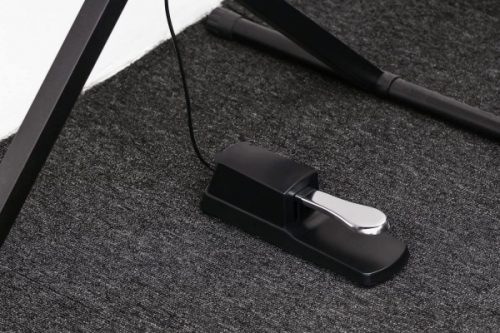How Do You Know Which Pedal to Play on the Piano
When looking under the piano you accept three contumely colored levers sticking out from the bottom. Pedals are unique to the piano, and their consequence cannot be understated. They are so important!
On an acoustic g or upright or pianoforte, those are the piano pedals! Many pianists wonder what practise the pedals on a piano do? Here yous can finally detect out and start making music! The pedals are an extremely of import component to the pianoforte, sheet music even has pedal markings.
Types of piano pedals
Pedals on the piano help to enrich the sound by making the notes sustain longer than normal or by accentuating the softer dynamics and consequently enhancing the emotional bear on of your music. Learning what the 3 pedals on pianoforte exercise is a necessary step on every pianist'south journey, and the first step is to learn the piano pedal names.
Sustain pedal

Location: correct pedal
Primary functions
- Also called Damper Pedal
- Sustains sounds played by the piano
- Allows for playing more piano notes beyond the instrument
- Blends sustained notes sound from multiple notes of the musical instrument together
How does it work?
The first pedal we will learn about is called the sustain pedal or damper pedal. These ii words are frequently used interchangeably to refer to the same pedal. On all acoustic grand or upright pianos, the sustain pedal is on the right side. If you are shut to your piano, and you accept never pushed downwardly this pedal, go over to your piano, printing downwardly the sustain pedal lightly with your foot, and play some keys. What happens when the hammers lift off the string? The sustain pedal causes selected notes to sustain for a period of time after you lift your finger off the keys. This pedal on the pianoforte adds a legato effect to your music, helps cord notes and chords together, and smoothen out transitions. It also adds a pleasant blurriness to your music, like to the impressionism of a watercolor painting. However, also much sustain pedal tin cause your music to become muddy and create indistinguishable sounds, and then you must learn how to wield its ability to your advantage.
The una corda pedal

Location: left pedal
Main functions:
- Una Corda means only one cord
- We also call this pedal the Soft Pedal
- Creates a muted, or muffled sound
- This pedal physically moves hammers inside the piano to play fewer 1 strings
- Apply it to play the Dynamic Marker pp, pianissimo, or extremely soft.
How does information technology work?
This dynamic means This dynamic is all-time achieved past pressing the soft pedal or the una corda pedal. On an audio-visual pianoforte, this is the pedal on the left side.The una corda pedal works differently on a one thousand pianoforte versus an upright piano.
On a k piano, depressing the soft pedal shifts the piano hammers to the correct so that the hammers but strike one string instead of ii or three. The result is a softer tone. This is where the proper noun una corda (i string) comes from. On an upright piano, pushing the soft pedal moves the hammers closer to the strings, thereby limiting the total distance the hammers can travel to strike the strings. This has a similar, muting effect.
The soft pedal is a beautiful, if delicate, audio. Anytime you see the dynamic markings pp, pianissimo, or una corda, you are being instructed to employ this pedal. You will find this pedal quite a bit in the piano music of French composer Claude Debussy and yous can practice using the soft pedal on Skoove'southward arrangement of the traditional tune "Greensleeves".
Sostenuto pedal

Location: yard iddle
Master functions
- The centre pedal can have 3 dissimilar functions
- The Sostenuto pedal
- The Bass damper pedal
- The Exercise pedal
How does it work?
The sostenuto pedal sustains only the notes that are held when the pedal is pressed. Any notes pressed afterwards the pedal will audio every bit they ordinarily would without the pedal. If y'all play a big chord loftier up on the pianoforte and appoint the sostenuto pedal with information technology, then the post-obit notes will sound discrete from the sustained chord, until you release the pedal.
The Bass Damper pedal functions like the damper pedal on the right side, but only affects the bass notes. Any notes higher up eye C on the piano sound similar normal.
The Do pedal. This type of pedal is almost ofttimes found on a modernistic upright piano. Do pedals soften the sound and lock into the down position so you practise non have to sit down there and hold it the entire fourth dimension you lot practice. This pedal allows you lot to exercise quietly significant you will not annoy your neighbors or housemates and is particularly useful if you lot live in an apartment or other shut dwelling. Now you know what the middle pedal on a piano does!
Digital pedals

Location: plugged into keyboard
Chief functions
- Many keyboards do not come with pedals
- All pedals plug into a ¼'' input jack
- Can be used to sustain instruments that are not pianos
- Sustain is recorded into DAW Recording Programs
How does it work?
Most keyboards come equipped with a ¼" input jack on the back that is usually labeled "sustain." If y'all are interested, y'all can buy a stand-alone sustain pedal for a reasonable price and incorporate that into your practice. Unfortunately, there are no coordinating soft and sostenuto pedals for digital keyboards, but many pianoforte plug-ins practise accept soft or sostenuto pedal functions. Digital upright pianos come with a standard three pedal arrangement like acoustic pianos, only now digital keyboards.
The internal mechanics
Have you ever taken a wait inside your acoustic piano? If not, take a moment and open the lid and examine the interior. Have you ever wondered what are the pedals on a pianoforte for?
When you depress the sustain pedal, the lilliputian blocks of felt called "dampers" are lifted abroad from the strings.The dampers are what mute the piano strings after you lot lift your finger off the keys. This is why the sustain pedal is sometimes called the damper pedal.
To use the pedal correctly, place your right foot in front end of the pedal, heel firmly on the floor, toes on the pedal lever. Your heel should remain on the floor equally you pedal, keeping your foot in place. Maintaining proper piano sitting posture is important. But your toes move upwardly and down to piece of work the pedal. How difficult you have to printing on the pedal varies from one piano to another. Information technology is a bit similar driving – every automobile feels a petty bit unlike.
How to use the piano pedals
A swell Skoove song to practise pedaling with is " Moonlight Sonata" . Utilise the damper pedal here to create a sense of reflection.
- Start by changing the pedal on the first shell of every measure.
- Aim to take the pedal off and put it downwardly once more but as you strike the new notes. Motion pedal in a swift up-and-downward activity.
- Hold pedal nigh to the downbeat.
There is an old proverb, "pedal with your ears". Make sure you are listening advisedly to how your pedaling sounds.
- If the notes are blurry, lift your foot higher off the pedal
- If the notes are not blending, apply more than pedal down on the pedal. It takes practice to get it right and for information technology to feel and sound effortless.
Skoove has many great lessons like the i mentioned above. If you are interested in checking it out more, you can sign up for a 7 solar day free trial. Skoove features over 400 lessons and a unique AI system that listens and responds to your playing in existent fourth dimension. It is awesome for students at any stage of life.
How to read pedal notation
At present that you know what the pedals on a piano are for, it is fourth dimension to acquire how the pedals on the piano are notated. You will commonly come across notation for the sustain and soft pedals, but rarely if ever for the eye pedal, unless you're playing a piece written for yard piano.
Notating the damper pedal
Pedal notation is easy to recognize. The notation for the sustain or damper pedal looks like this:

This example begins with heart C on the piano . The indication Ped tells yous to play the sustain pedal, the extended horizontal line across the first measure means hold the sustain pedal down, the triangle at the kickoff of the second measure out means to refresh the pedal, and finally the vertical line at the cease of the second measure means elevator the pedal for adept. Simple, correct?
You may as well see this note:

Ped. simile means to continue pedaling in the same style. In this instance, that means refreshing the pedal before the start of each new measure.
Notating the soft pedal
Notation for the soft pedal is accomplished with either the dynamic mark pp meaning pianissimo or very tranquility, or the dynamic marking una corda, meaning one string. Here is an example:

If you see a marking like this in music, information technology means these chords should be played with the soft pedal depressed. You lot tin can attempt using the sostenuto pedal with some basic piano chords as well.
But, digital keyboards take a unlike advantage: yous can explore the wide world of guitar and bass effects pedals! Delay pedals, reverb pedals, fuzz, overdrive, and octave pedals, and more! If y'all are curious, there is truly no end to the sounds you can explore downwards that pathway with pedals on the piano! Perhaps you don't want to make the only sounds from a pianoforte? Digital pianos can accommodate themselves to sound like any instrument or percussion, or fifty-fifty play samples of voices.
Final words
Pedals are the key to making interesting sounding music on a piano, and their importance can never be overlooked. With proper pedals yous can too make your digital keyboard audio merely like a real acoustic piano, with strings long plenty to make the bass notes ring. Learning pianoforte truly is the best way to understand how to make music, and the best way to do that is through online piano lessons. At present that you know how to use sustain pedals you can finally play moody classical music, or long beautiful chords that migrate away slowly. Savor making moody pianoforte music!
Attempt out your free trial of Skoove today!
Author of this blog post:

bridgetherkilinde1950.blogspot.com
Source: https://www.skoove.com/blog/guide-piano-pedals/
0 Response to "How Do You Know Which Pedal to Play on the Piano"
Post a Comment